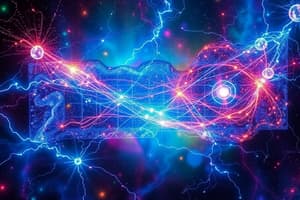Podcast
Questions and Answers
What is the defining characteristic of noble gases in terms of their chemical reactivity?
What is the defining characteristic of noble gases in terms of their chemical reactivity?
- They only react at extremely high temperatures
- They do not react chemically with most substances (correct)
- They react vigorously with most substances
- They are highly reactive with water
When were helium and neon first discovered?
When were helium and neon first discovered?
- Helium and neon both in the 20th century
- Helium in the 18th century, neon in the 19th century
- Helium in the 19th century, neon in the 20th century
- Helium and neon both in the 19th century (correct)
What is the common feature in the atomic structure of noble gases that contributes to their stability?
What is the common feature in the atomic structure of noble gases that contributes to their stability?
- Incomplete outermost electron shell
- Absence of protons in the nucleus
- Outermost electron shell filled with electrons (correct)
- Varying number of neutron shells
Which noble gas element was identified last among helium, neon, argon, krypton, xenon, and radon?
Which noble gas element was identified last among helium, neon, argon, krypton, xenon, and radon?
What is the nucleus of each noble gas element composed of?
What is the nucleus of each noble gas element composed of?
Why do noble gases have low boiling and melting points?
Why do noble gases have low boiling and melting points?
In which application is neon commonly used?
In which application is neon commonly used?
What unique feature of radon limits its applications?
What unique feature of radon limits its applications?
How does helium contribute to the production of crystals?
How does helium contribute to the production of crystals?
What practical lesson do noble gases teach us about chemistry?
What practical lesson do noble gases teach us about chemistry?
Flashcards are hidden until you start studying
Study Notes
Discovering the Quiet Corner of the Periodic Table: Noble Gases
In the vast landscape of elements that make up our world, a unique group of gases stands out for their distinctive properties and behavior. Known as the noble gases, this collection of six elements — helium (He), neon (Ne), argon (Ar), krypton (Kr), xenon (Xe), and radon (Rn) — is often referred to as the inert gases due to their tendency to not react chemically with most substances.
Isolation and Discovery
Noble gases were discovered in the 19th century by chemists who noticed that certain gases, despite being isolated from air, remained uncombined under various conditions. Helium, for instance, was first detected in 1868 during spectroscopic analysis of the Sun's atmosphere by Jules Janssen and Norman Lockyer. Neon, argon, krypton, and xenon were also discovered by the early 1900s. Radon, the heaviest of the noble gases, was identified in the 1930s.
Electronic Configuration
The noble gases have a common characteristic in their atomic structure: the outermost electron shell is completely filled with electrons. This configuration, known as the noble gas configuration, gives them a high degree of stability and a tendency not to participate in chemical reactions. The nucleus of each noble gas element consists of a dense core of protons and neutrons, surrounded by a series of electron shells. In the noble gases, the last electron shell contains either eight electrons (for He, Ne, and Ar) or 18 electrons (for Kr, Xe, and Rn).
Physical Properties
Noble gases are monoatomic elements, meaning their atoms exist independently. As gases, they have low boiling and melting points, and they are colorless, odorless, and tasteless. Noble gases are also relatively unreactive, non-toxic, and have low solubility in water. These properties make them useful in various applications, such as heating, lighting, and as protective atmospheres in high-vacuum systems.
Applications
While most noble gases are used for their inert properties, some have unique features that make them valuable for specific applications.
- Helium: A low-density gas, helium has applications in balloons, as a coolant for superconducting magnets and nuclear reactors, and as a shielding gas in welding and growing crystals.
- Neon: Known for its bright red glow, neon is used for decorative lighting, lasers, and in gas-discharge tubes, such as neon signs.
- Argon: A heavy noble gas, argon is used in light bulbs, as a shielding gas for welding and growing crystals, and in the production of other chemicals.
- Krypton: Krypton is used as a filling gas in electric discharge lamps, in lasers, and as a shielding gas for growing crystals.
- Xenon: Xenon is used in high-intensity lamps, as a propellant for spacecraft, and in anesthesia.
- Radon: Although it is a radioactive gas, radon has limited applications as a tracer gas and in medical imaging.
Summary
Noble gases are a unique group of elements that, due to their filled electron shells, exhibit exceptional chemical inertness. These elements have practical applications, including lighting, heating, and protection of materials, as well as unique properties that make them valuable in specialized settings. Understanding the nature of noble gases has provided valuable lessons about electron shells and chemical bonding, leading to a deeper understanding of chemistry. Even as we continue to explore the properties and applications of noble gases, their importance in our world remains strong.
Studying That Suits You
Use AI to generate personalized quizzes and flashcards to suit your learning preferences.




